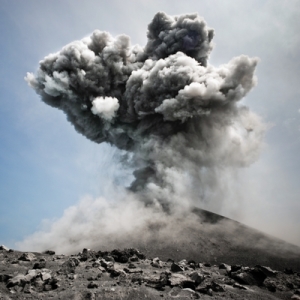Volcanic chains formed by two sources

Matter from the core-mantle boundary and continental drift
Geological experts differ on how volcanic chains such as the Hawaiian or Canary Islands are formed in the ocean. It is understood that some volcanic chains are formed by mantle plumes, hot matter rising from the Earth’s inner core, while other oceanic volcanoes emerge from tectonic-plate activity. Dr. John O’Connor, a researcher from the Chair of Endogenous Geodynamics at Friedrich-Alexander-Universität Erlangen-Nürnberg (FAU) and a team of international researchers investigated oceanic volcanoes in the South Atlantic. The research shows how the different processes interact to form volcanic structures and was published online in the ‘Nature Geoscience’ magazine on 16 September 20121).
Dr. O’Connor and his colleagues from the Netherlands, South Africa, Australia, the USA and from the Alfred Wegener Institute in Bremerhaven were able to pinpoint the eruption date of rock samples from several volcanic chains at a large oceanic rise in the South Atlantic. The age distribution of the samples matches the movement of the African plate over a rising mantle plume from one of the two largest and deepest anomalies in the core-mantle boundary at a depth of approximately 2900 km.
The research group was able to demonstrate that the formation of the volcanoes began at the edge of the oceanic rise where the oceanic crust was spread by tectonic movement; later volcanism at the centre of the rise only occurred in areas with a newer and thinner lithospheric plate, where the flat structure of the plate directs the rising of mantle plume magma. In this respect, both processes in the Earth’s crust and the Earth’s mantle played a part in the formation of oceanic volcanoes.
1) DOI: 10.1038/NGEO1583
Further information:
Dr. John O‘Connor
Phone: +49 (0) 9131 85 22398
j.m.oconnor@vu.nl